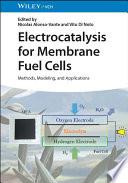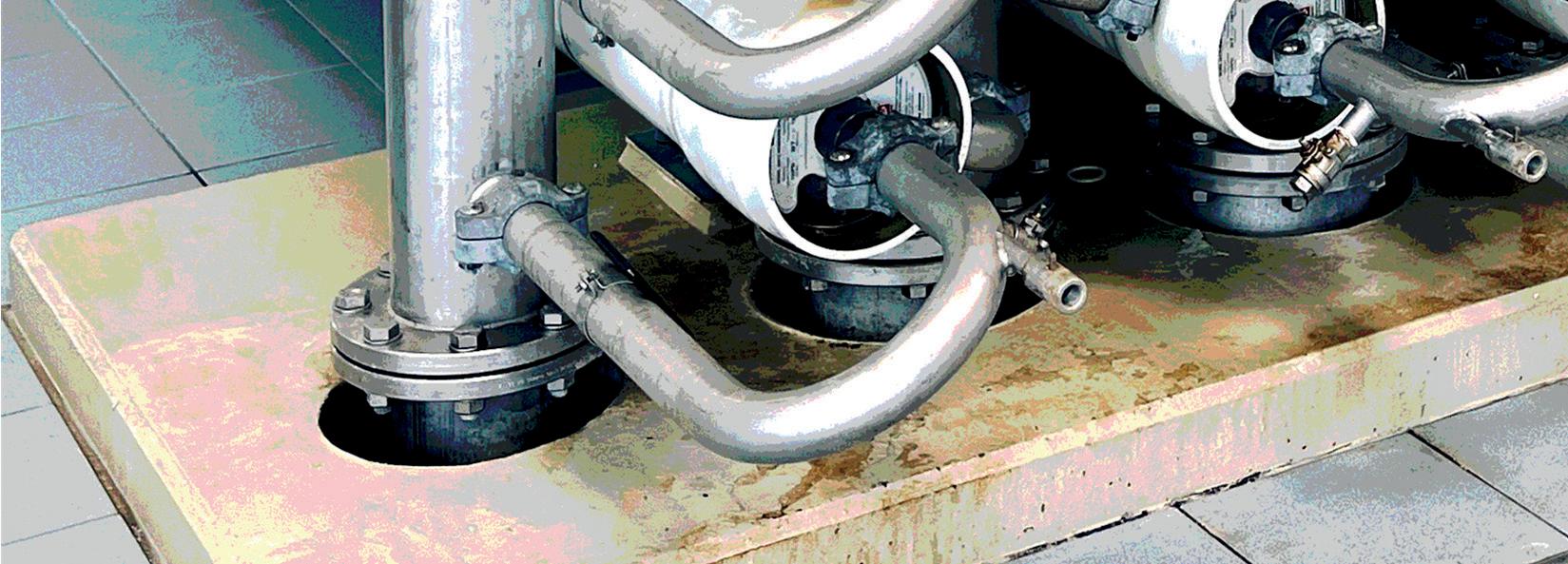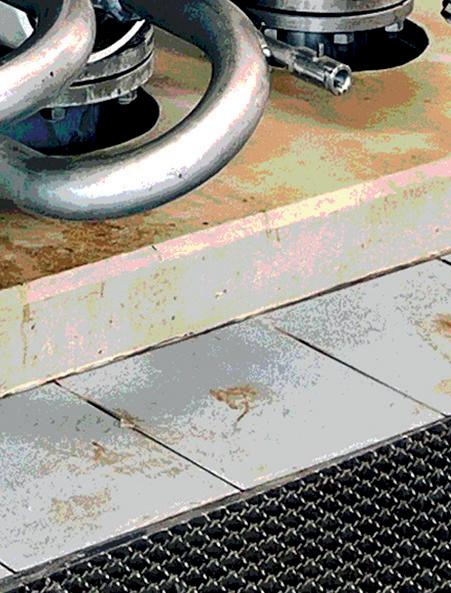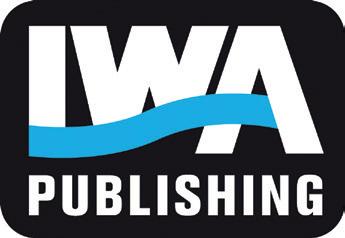Experimental Methods for Membrane Applications in Desalination and
Water Treatment
LOREEN O. VILLACORTE
SERGIO G. SALINAS-RODRÍGUEZ
Published by: IWA Publishing
Unit 104 – 105, Export Building
1 Clove Crescent
London E14 2BA, UK
Telephone: +44 (0)20 7654 5500
Fax: +44 (0)20 7654 5555
Email: publications@iwap.co.uk
Web: www.iwapublishing.com
First published 2024 © 2024 IWA Publishing
Apart from any fair dealing for the purposes of research or private study, or criticism or review, as permitted under the UK Copyright, Designs and Patents Act (1998), no part of this publication may be reproduced, stored or transmitted in any form or by any means, without the prior permission in writing of the publisher, or, in the case of photographic reproduction, in accordance with the terms of licences issued by the Copyright Licensing Agency in the UK, or in accordance with the terms of licenses issued by the appropriate reproduction rights organization outside the UK. Enquiries concerning reproduction outside the terms stated here should be sent to IWA Publishing at the address printed above.
The publisher makes no representation, express or implied, with regard to the accuracy of the information contained in this book and cannot accept any legal responsibility or liability for errors or omissions that may be made.
Disclaimer
The information provided and the opinions given in this publication are not necessarily those of IWA and IWA Publishing and should not be acted upon without independent consideration and professional advice. IWA and IWA Publishing will not accept responsibility for any loss or damage suffered by any person acting or refraining from acting upon any material contained in this publication.
British Library Cataloguing in Publication Data
A CIP catalogue record for this book is available from the British Library
Library of Congress Cataloguing in Publication Data
A catalogue record for this book is available from the Library of Congress
Reference:
Salinas Rodriguez SG, Villacorte LO (2024) Experimental Methods for Membrane Applications in Desalination and Water Treatment, 1st edn IWA Publishing, London. doi: 10.2166/9781789062977
Cover design: Hans Emeis
Graphic design: Hans Emeis
ISBN 9781789062960 (Hardback)
ISBN 9781789062977 (eBook)
ISBN 9781789062984 (ePub)
This is an Open Access book distributed under the terms of the Creative Commons Attribution Licence (CC BY-NC-ND 4.0), which permits copying and redistribution for non-commercial purposes with no derivatives, provided the original work is properly cited (https:// creativecommons.org/licenses/ by-nc-nd/4.0/). This does not affect the rights licensed or assigned from any third party in this book.
Foreword
Experimental Methods for Membrane Applications in Desalination and Water Treatment
Water
Few other substances are so abundant on our beautiful planet that they would be able to cover it in a layer more than three kilometers thick. Seen from space, our planet is blue and white from water.
Still, water scarcity is a grave and global issue, because water is often not in the right place, at the right time, and in the right quality. This book is dedicated to the last issue, water quality. More specifically, the focus is on experimental membrane processes in water treatment (this, of course, you will have picked up from the book title). Membrane processes in water treatment are literally as old as life itself, but still a vibrant experimental field, as will be clear when you enjoy the book.
As a technology, membrane filtration is highly effective, proven to be able to mitigate the increasingly global challenges of water scarcity and limited access to clean water. Depending on membrane type, the filtration process can remove a wide range of water contaminants, making it uniquely suitable for purifying unconventional but abundant water sources such as seawater, highly polluted surface or groundwater, and various types of wastewater. As water scarcity impacts billions of people globally, thousands of membrane-based purification plants have been planned or installed in both developed and developing regions. This means that plant engineers and operators who have process and analytical knowledge of membrane technology are urgently needed. Researchers are also needed to further improve the sustainability and economic feasibility of the technology.
Unfortunately, knowledge on membrane processes is currently fragmented in various academic publications, most of which are not freely available to operators, engineers and researchers, particularly in developing countries. This book aims to address this critical issue by bringing it all together in a series of chapters written by some of the foremost experts in the field.
The Grundfos Foundation is proud to co-sponsor this book.
Poul Toft Frederiksen Head of Programme, Research and Learning, The Grundfos Foundation
Contributors
Aamer Ali, PhD, MSc, Assistant Professor 5 Center for Membrane Technology, Department of Chemistry and Bioscience, Aalborg University, Denmark
Adam C. Hambly, PhD, Senior Researcher Water Technology & Processes 12 Dep. of Environmental and Resource Engineering, Technical University of Denmark, Denmark
Alberto Tiraferri, PhD, MSc, Full Professor of Applied Environmental Engineering 4 Department of Environment, Land and Infrastructure Engineering, Politecnico di Torino, Italy
Almotasembellah Abushaban, PhD, MSc, Assistant Professor in Water Desalination 1, 7, 15 The Applied Chemistry and Engineering Research Center of Excellence, Mohammed VI Polytechnic University, Morocco
Barun Lal Karna, ME (Research), Assistant Chief Engineer, Sofitel Sydney Darling Harbour 11 Water Research Centre, School of Civil and Environmental Engineering, University of New South Wales, Australia
Cejna Anna Quist-Jensen, PhD, MSc, Associate Professor of Membrane Technology 5 Center for Membrane Technology, Department of Chemistry and Bioscience, Aalborg University, Denmark
Claus Hélix-Nielsen, PhD, MSc, Professor DTU Sustain 4 & President Danish Natural Sciences Academy Head of Dep. of Environmental and Resource Engineering, Technical University of Denmark, Denmark
Francisco Javier García Picazo, MEng, Assistant Chemist 19 Environmental Chemistry Services, City of San Diego, United States of America
Guillem Gilabert-Oriol, PhD, MSc, Research and Development Leader 2, 3 DuPont Water Solutions, Spain, Adjunct Professor in the Universitat Rovira i Virgili, Spain
Gustavo A. Fimbres Weihs, PhD, Lead Research Fellow 19 School of Chemical and Biomolecular Engineering, The University of Sydney, Australia
Helen Rutlidge, PhD, BSc, Lecturer 11 School of Chemical Engineering, University of New South Wales, Australia
Helga Calix Ponce, MSc, Researcher 13 Denmark
Irena Petrinic, PhD, MSc, Associate Professor 4 University of Maribor, Slovenia
Jan Frauholz, MSc, Process Engineer 4 Aquaporin A/S, Denmark & RWTH Aachen, Germany
Javier Rodriguez Gómez, Laboratory supervisor 18 Genesys and PWT brands, H2O innovation, Spain
Jia Xin Tan, BEng
Faculty of Chemical and Process Engineering Technology, Universiti Malaysia Pahang Al-Sultan Abdullah, Malaysia
Johannes S. Vrouwenvelder, PhD, MSc, Professor of Environmental Science and Engineering, 17 Director of Water Desalination and Reuse Center (WDRC)
Biological & Environmental Science & Engineering Division (BESE), King Abdullah University of Science and Technology (KAUST), Saudi Arabia
Delft University of Technology , Faculty of Applied Sciences, Department of Biotechnology , The Netherlands
Karima Bakkali, BSc, Research Engineer
Mohammed VI Polytechnic University, Morocco
Kathleen Foo, MSc, PhD Research Fellow 19 Faculty of Chemical and Process Engineering Technology, Universiti Malaysia Pahang Al-Sultan Abdullah, Malaysia
Léonie Le Bouille, MSc, Research Fellow 15 IHE Delft Institute for Water Education / CIRSEE Suez / Delft University, The Netherlands / France
Loreen O. Villacorte, PhD, MSc, Lead Water Treatment Specialist 1, 13 Global Technology and Innovation, Grundfos Holding A/S, Denmark
Luca Fortunato, PhD, MSc, Research Scientist 17 Water Desalination and Reuse Center (WDRC), Biological & Environmental Science & Engineering Division (BESE), King Abdullah University of Science and Technology (KAUST), Saudi Arabia
Lucia Ruiz Haddad, MSc, PhD Candidate 14
Environmental Science and Engineering Program, Biological and Environmental Science and Engineering (BESE) Division, King Abdullah University of Science and Technology (KAUST), Thuwal, Kingdom of Saudi Arabia
Maria Salud Camilleri-Rumbau, PhD, MSc, Researcher, R&D Project Manager 4 Technology Centre of Catalonia - Fundació Eurecat, Spain / Aquaporin A/S, Denmark
Mohamed Chaker Necibi, PhD, Associate Professor in Circular Economy 15 International Water Research Institute (IWRI), Mohammed VI Polytechnic University, Morocco
Mohamed Fauzi Haroon, PhD, Associate Director Analytical Science & Technology 14 Moderna, United States of America
Mohammad Mahdi A. Shirazi, PhD, MSc, Senior Postdoctoral Fellow 5 Center for Membrane Technology, Department of Chemistry and Bioscience, Aalborg University, Denmark
Mohaned Sousi, PhD, MSc 16 Water Supply, Sanitation and Environmental Engineering Department, IHE Delft Institute for Water Education, The Netherlands
Morten Lykkegaard Christensen, PhD, MSc, Associate Professor of Wastewater Treatment 2 and Membrane Technology Department of Chemistry and Bioscience, Aalborg University, Denmark
Muhammad Ali, PhD, Martin Naughton Assistant Professor in Environmental Microbiology 14 Department of Civil, Structural & Environmental Engineering, Trinity College Dublin, The University of Dublin, Ireland
Muhammad Nasir Mangal, PhD, MSc 10 Membrane specialist, Berghof Membranes, The Netherlands
Nuria Peña García, PhD, MSc, Research Director 9, 18 Director of Scientific Global Services for Genesys and PWT brands, H2O innovation, Spain
Pascal E. Saikaly, PhD, MSc, Professor of Environmental Science and Engineering, 14 Chair of Environmental Science and Engineering Program, Biological and Environmental Science and Engineering (BESE) Division, King Abdullah University of Science and Technology (KAUST), Thuwal, Kingdom of Saudi Arabia
Pierre Le-Clech, PhD, MSc, Associate Professor of Water and Wastewater treatment 11 School of Chemical Engineering, University of New South Wales, Australia
Poul Toft Frederiksen, PhD, MSc, Head of Programme Research and Learning F The Grundfos Foundation, Denmark
Pouyan Mirzaei Vishkaei, MSc 1 Researcher, Water Supply, Sanitation and Environmental Engineering Department, IHE Delft Institute for Water Education, The Netherlands
Rita Kay Henderson, PhD, MSc, Professor of Water Quality and Treatment 11 School of Chemical Engineering, University of New South Wales, Australia
Sergio G. Salinas-Rodriguez, PhD, MSc, Associate Professor of Water Supply Engineering 1, 7, 8, 15 Water Supply, Sanitation and Environmental Engineering Department, IHE Delft Institute for Water Education, The Netherlands
Steven J. Duranceau, PhD, PE, Professor and Director 6 Environmental Systems Engineering Institute Department of Civil, Environmental & Construction Engineering, College of Engineering and Computer Science, University of Central Florida, United States of America
Urban J. Wünsch, PhD, Postdoctoral Researcher 12 National Institute of Aquatic Resources, Technical University of Denmark, Denmark
Vanida A. Salgado-Ismodes, MSc, PhD research fellow 7 Water Supply, Sanitation and Environmental Engineering Department, IHE Delft Institute for Water Education, The Netherlands
Victor Augusto Yangali Quintanilla, PhD, MSc, Lead Water Treatment Specialist 4 Global Technology and Innovation, Grundfos Holding A/S, Denmark
Victoria Sanahuja-Embuena, PhD, MSc, Chemical Engineer, Scientist 4 Aquaporin A/S, Denmark
Wen Yew Lam, BEng 19 Faculty of Chemical and Process Engineering Technology, Universiti Malaysia Pahang Al-Sultan Abdullah, Malaysia
Weng Fung Twong, BEng 19
Faculty of Chemical and Process Engineering Technology, Universiti Malaysia Pahang Al-Sultan Abdullah, Malaysia
Xuan Tung Nguyen, BSc, Project Manager 4
Aquaporin Asia, Singapore
Yie Kai Chong, BEng 19
Faculty of Chemical and Process Engineering Technology, Universiti Malaysia Pahang Al-Sultan Abdullah, Malaysia
Yuli Ekowati, PhD, MSc, Postdoctoral Researcher 1, 13
Global Technology and Innovation, Grundfos Holding A/S, Denmark
Yong Yeow Liang, PhD, Senior Lecturer 19
Faculty of Chemical and Process Engineering Technology, Centre for Research in Advanced Fluid and Processes, Universiti Malaysia Pahang Al-Sultan Abdullah, Kuantan, Pahang, Malaysia
About the editors
Sergio G. Salinas-Rodriguez is Associate Professor and desalination and water treatment technology professional at IHE Delft Institute for Water Education. He has a PhD in Desalination and Water Treatment from the Technical University of Delft, an MSc in Water Supply Engineering from UNESCO-IHE Institute for Water Education, a Master’s in Irrigation and Drainage and a BSc in Civil Engineering from San Simon Major University. He also obtained the University Teaching Qualification in the Netherlands.
He has over 75 publications in books, chapters, international peer-reviewed journals and conference proceedings in the areas of seawater and brackish water desalination, water treatment, water reuse, and natural organic matter characterization.
Sergio is involved in teaching and curriculum development of the MSc Programme in Water and Sustainable Development at IHE Delft. His projects comprise capacity building, research and innovation (e.g., EU-MEDINA, EU-MIDES, EU-MAR2PROTECT). He has mentored more than 50 MSc students, co-promoted 4 PhD students, and currently supervises 2 PhD students. Sergio lectures and coordinates several courses on Desalination and membrane technology.
Loreen Ople Villacorte is Lead Water Treatment Specialist at Global Technology and Innovation in Grundfos Denmark. He has broad experience in research, conceptualization, development and validation of water treatment technologies including applications of traditional and emerging membrane technologies.
For the last 18 years, he has held various roles in the academia and the industry across three countries (Philippines, Netherlands and Denmark), primarily driving research and technology development projects to tackle water challenges in drinking water production and transport, wastewater treatment or reuse, oil-water separation and industrial cooling systems. Most of these projects were implemented through cross-functional collaborations and involves understanding the physics, biology and chemistry of water to enable development of effective treatment solutions. He has published >25 scientific articles and filed numerous patents in water treatment and desalination applications.
He is a civil engineer with a master’s degree in water supply engineering at IHE-Delft and a doctoral degree in desalination and water treatment from the Technical University of Delft, IHE-Delft and Wetsus.
3.4
3.4.3.1
3.4.3.2
3.4.3.3
3.4.3.4
3.5
3.8.1
3.8.2
3.8.3
3.8.4
3.8.5
4.3
4.4
4.5
4.6
4.7
Chapter 5
5.2
5.3
5.2.1
5.2.3.1
5.2.3.2
5.2.4
5.3.1
5.3.1.1
5.3.1.2
5.3.1.3
5.3.2
5.3.2.1
Part 2
6.1
6.2
6.4
Chapter 7
7.1
7.2
7.3
7.3.1
7.3.1.1
7.3.1.2
7.4
7.5
7.6
7.7
7.3.1.8
7.3.2
7.3.3
7.5.1
7.8 References
Chapter 8
Modified
8.1
8.2 Theor
8.2.1
8.2.2
8.3
8.3.1
8.3.1.1
8.3.1.2
8.3.1.3
8.3.1.4
8.3.1.5
8.3.1.6
8.3.1.7
8.3.1.8
8.3.2
8.3.3
8.3.3.1 Selection of filtration flux rate
8.3.4 Calculation procedure
8.3.4.1 Example of membrane resistance calculation of UPW
8.3.4.2 Example of MFI-UF calculation
8.3.5 Reproducibility
8.3.6
8.3.7 Sample storage
8.3.8 Concentration of particles
8.3.9 Membrane material
8.4 Variables and applications of the MFI-UF
8.4.1 Plant profiling and water quality monitoring
8.4.2 Flux rate
8.4.3 Predicting rate of fouling of seawater RO systems
8.4.4 Comparing fouling indices
8.5 References
Part 3
Chapter 9
Inorganic Fouling Characterization Tools and Mitigation
9.2 Main components of inorganic fouling
9.2.1
9.2.2
9.2.3
9.2.4
9.3
9.4
Chapter 10
Assessing Scaling Potential with Induction Time and a Once-through Laboratory Scale RO System
10.1 Introduction
10.2 Induc tion time measurements
10.2.1.4 Peristaltic pump
10.2.1.5 Thermostat
10.2.2 Experimental procedure
10.2.2.1 Preparation of artificial brackish water
10.2.2.2 Induc tion time measurement
10.2.3 Calculation of induction time
10.2.4 Cleaning of the reactor
13.2.3
13.2.4.2
13.2.4.3
13.2.4.4
13.2.5
13.2.5.1
13.2.5.2 Impac t of storage on TEP concentration
14.2 Experimental design and sample preparation
14.2.1 Experimental design in a metagenomics
14.2.4
14.3 Bioinformatics analysis
14.3.1
14.3.3 Metagenomics, read-based approach
14.3.4 Metagenomics, assembly-based approach
14.3.5 Metagenome-assembled genome (MAG) binning
14.3.6 Super vised and unsupervised binning
14.3.7 Func tional annotation
14.3.8 Genome-resolved metatranscriptomics
14.4 Data sharing and storage
14.5 Bioinformatics analysis workflow examples
14.5.1 Amplicon sequences processing workflow
14.5.2 Genome-resolved metagenomics
14.5.3 Genome-resolved metatranscriptomics
14.6 Applications of genomics in membrane filtration research
14.8 Data availability
14.9 References
Chapter 15
15.1 Introduction
15.2
15.4
15.3.3
15.3.4
15.3.5
15.3.6
15.4.1
Chapter 16
Chapter 17
17.6.2
17.7.3
17.7.4
17.7.5
Part 6
Chapter 18
Chapter 19
19.1.1
19.2.1
19.2.2.1 1D, 2D and 3D
19.2.2.2
19.2.2.3
19.2.2.4
19.2.3
19.2.3.1
19.2.4
19.2.5
19.2.6
19.3
19.3.1
19.4.1.1
19.5.1.2
19.5.1.3
19.5.1.4
19.5.2
19.5.4.2
19.5.4.3
19.5.4.4
19.5.4.5
19.5.5
doi: 10.2166/9781789062977_0001
Experimental Methods for Membrane Applications
Table 1 Parameters and recommended guideline values for RO feed water ParameterUnitDuPont (2023)
(a)Particulate fouling indicators
SDI15 %/min<5 (target <3)<5 (target <3) (Wilf and Klinko, 2016)
< 3 (Badruzzaman et al., 2019) < 4 (Voutchkov, 2010)
(ASTM D4189 - 07)
MFI-0.45 s/L2 4 (target <1)
MFI-UF s/L2 - <490 at 15 lmh (safe MFI*) (Salinas Rodríguez, 2011)
Turbidity NTU< 1 < 0.5 (Badruzzaman et al., 2019) < 0.1 (Voutchkov, 2010)
(b)Organic fouling indicators
(ASTM D8002 - 15)
(ASTM D1889-00)
Oil and greasemg/L0.1 < 0.1 (Badruzzaman et al., 2019) < 0.02 (Voutchkov, 2010) (ASTM D7575-11)
TOC mg-C/L3 < 2 (Badruzzaman et al., 2019) < 2 (target <0.5) (Voutchkov, 2010)
SUVA L/mg-m
< 4 (USEPA, 2005)
(ASTM D2579-93e1)
COD mg/L10 (ASTM D125206(2020))
(c)Biological fouling indicators
AOC µg/L Ac-C10 (target <5)<10 µg-C acetate/L (threshold for biofouling in freshwater) (van der Kooij et al., 1982)
(NEN 6271:1995 nl)
BGPµg-C/L- - <70 (Abushaban, 2019)
BFRpg-ATP/ cm2 5 (target <1)< 1 (Vrouwenvelder and van der Kooij, 2001)
PO4-Pµg/L 0.3 µg P/L (Vrouwenvelder et al., 2010)
(d)Inorganic fouling and scaling indicators
Ferrous ironmg/L4 < 2 (Badruzzaman et al., 2019) < 2 (Voutchkov, 2010) (ASTM D1068-15)
Ferric ironmg/L0.05 < 0.1 (Badruzzaman et al., 2019) <0.05 (Voutchkov, 2010) (ASTM D1068-15)
Manganesemg/L0.05 0.05 (Badruzzaman et al., 2019) 0.02 (Voutchkov, 2010) (ASTM D858-17)
Aluminiummg/L0.05 (ASTM D857-17)
Silicamg/L 20 (Badruzzaman et al., 2019)(ASTM D85916(2021)e1)
pH - 4-11 (Voutchkov, 2010)(ASTM D1293-12)
LSI (freshwater) - Concentrate LSI < 0 (if no antiscalant is added) (ASTM D3739-19)
ParameterUnitDuPont (2023)
S&DSI (seawater) - Concentrate
S&DSI < 0 (if no antiscalant is added)
(e)Membrane material limits
Temperature°C
(ASTM D458291(2001))
< 35 (Voutchkov, 2010)
Free chlorinemg/L<0.1 < 0.1 (Badruzzaman et al., 2019) < 0.01 (Voutchkov, 2010) (ASTM D125314(2021)e1)
ORPmV<175-200
Parameter Unit DuPont (2023)
Other sources
(ASTM D149814(2022)e11)
Standard Methods
* Safe MFI is a value for RO feedwater that will yield a 1 bar pressure increase in a 6 months period.
In addition to the established feedwater quality parameters in Table 1, tens of thousands of scientific articles and patents were published over the past 30 years describing or applying new assessment tools/indices for evaluating the fouling/scaling potential of RO feedwater as well as to characterize the impact of specific feedwater components to RO operation (Figure 3). Some of these tools were also applied to optimize the design and operation of RO pre-treatment system, including MF/UF processes (see Chapter 2). The succeeding sections review the advantages as well as the challenges of applying these assessment tools in membrane-based desalination systems.
Figure 3 Number of scientific and patent publications related to fouling and scaling assessment in reverse osmosis process from 1990 and 2023 (November). Data generated through Google Scholar using the search string: “(fouling OR scaling) AND (characterization OR assessment OR potential OR indicator OR index) AND (reverse osmosis)”.
1.2 PARTICULATE FOULING POTENTIAL
Fouling indices to measure the particulate fouling potential of RO feedwater have been in development since the 1960’s (Figure 4). The oldest and most widely used index, the silt density index (SDI) has been standardised by ASTM D4189 - 14 (2014), is applied worldwide as it is simple to perform and with low-cost consumables (see Chapter 6).






















